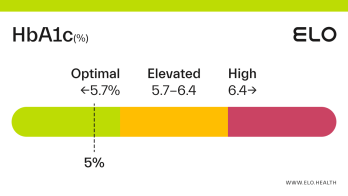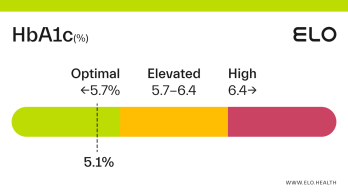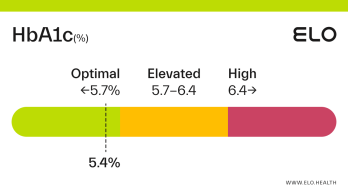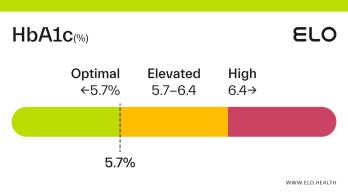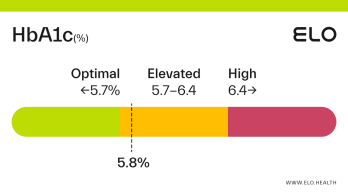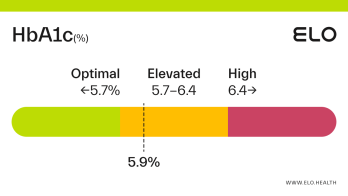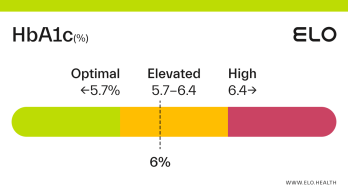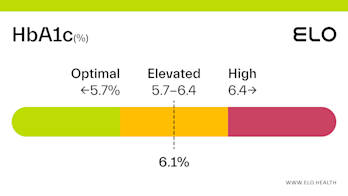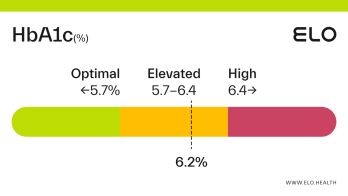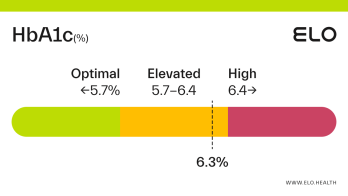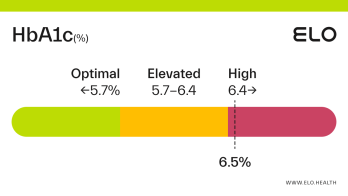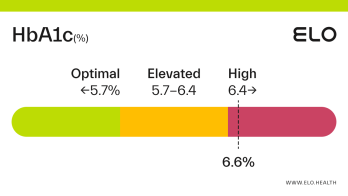HbA1c: 5.6
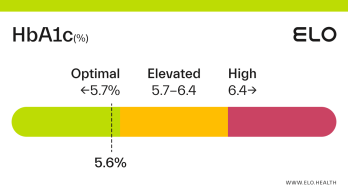
What does an A1c level of 5.6 mean?
A hemoglobin A1c (aka HbA1c or A1c) level of 5.6 is considered optimal.
An A1c of 5.6 means that 5.6% of the hemoglobin in your blood is saturated with sugar. A1c levels between 4 and 5.6 percent indicate good blood glucose control over the last 2-3 months. Maintaining an optimal A1c is important for preventing diabetes and the complications associated with this disease.
How to maintain optimal A1c levels
An A1c level of 5.6% means you have had good blood glucose control over the last few months. A1c tends to increase with age [4], so it’s important to have your levels checked on occasion, especially if you’re at greater risk for prediabetes or diabetes.
Groups that are at greater risk for developing prediabetes/ diabetes include:
Adults age 45 or older
People of Black, Hispanic/Latino, American Indian, Asian American, or Pacific Islander descent
Those with a parent, brother, or sister with diabetes
Overweight or obese individuals
People who are sedentary/ not physically active
Individuals with low HDL (good) cholesterol and/or high triglycerides
Those with high blood pressure, or who take medicine for high blood pressure
Women who had diabetes during pregnancy or who have been diagnosed with polycystic ovary syndrome (PCOS)
Regardless of whether or not you’re at increased risk for prediabetes/ diabetes, eating a healthy, balanced diet and being active are key to maintaining optimal A1c levels. Here are some things you can do to maintain a healthy A1c:
Be physically active for 30-60 minutes most days of the week.
At every meal, fill half of your plate with non-starchy veggies. Incorporate lean protein and plant-based fats as well, to assist with blood sugar control.
Avoid refined carbohydrates and too much added sugar. Choose whole-grain carbs such as whole wheat bread/ pasta, quinoa, farro, and steel-cut oats, instead.
Lose excess weight if you are overweight or obese.
If you have diabetes, follow your diabetes treatment plan.
Lower stress levels and get adequate sleep to help balance hormone levels that can affect blood sugar.
References
All About Your A1C. (2018, August 21). Centers for Disease Control and Prevention.
https://www.cdc.gov/diabetes/managing/managing-blood-sugar/a1c.html
Diabetes Risk - What Causes Diabetes. (n.d.). American Diabetes Association. Retrieved September 14, 2021, from
https://www.diabetes.org/diabetes-risk
Cherney, K. (2020, June 18). A Complete List of Diabetes Medications. Healthline.
https://www.healthline.com/health/diabetes/medications-list
Pani, L. N., Korenda, L., Meigs, J. B., Driver, C., Chamany, S., Fox, C. S., Sullivan, L., D'Agostino, R. B., & Nathan, D. M. (2008). Effect of aging on A1C levels in individuals without diabetes: evidence from the Framingham Offspring Study and the National Health and Nutrition Examination Survey 2001-2004. Diabetes care, 31(10), 1991–1996.
https://doi.org/10.2337/dc08-0577

